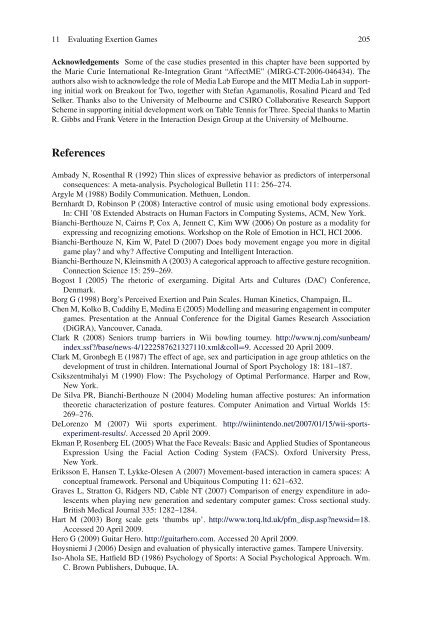Evaluating User Experience in Games: Concepts and Methods - Lirmm
Evaluating User Experience in Games: Concepts and Methods - Lirmm
Evaluating User Experience in Games: Concepts and Methods - Lirmm
Create successful ePaper yourself
Turn your PDF publications into a flip-book with our unique Google optimized e-Paper software.
11 <strong>Evaluat<strong>in</strong>g</strong> Exertion <strong>Games</strong> 205<br />
Acknowledgements Some of the case studies presented <strong>in</strong> this chapter have been supported by<br />
the Marie Curie International Re-Integration Grant “AffectME” (MIRG-CT-2006-046434). The<br />
authors also wish to acknowledge the role of Media Lab Europe <strong>and</strong> the MIT Media Lab <strong>in</strong> support<strong>in</strong>g<br />
<strong>in</strong>itial work on Breakout for Two, together with Stefan Agamanolis, Rosal<strong>in</strong>d Picard <strong>and</strong> Ted<br />
Selker. Thanks also to the University of Melbourne <strong>and</strong> CSIRO Collaborative Research Support<br />
Scheme <strong>in</strong> support<strong>in</strong>g <strong>in</strong>itial development work on Table Tennis for Three. Special thanks to Mart<strong>in</strong><br />
R. Gibbs <strong>and</strong> Frank Vetere <strong>in</strong> the Interaction Design Group at the University of Melbourne.<br />
References<br />
Ambady N, Rosenthal R (1992) Th<strong>in</strong> slices of expressive behavior as predictors of <strong>in</strong>terpersonal<br />
consequences: A meta-analysis. Psychological Bullet<strong>in</strong> 111: 256–274.<br />
Argyle M (1988) Bodily Communication. Methuen, London.<br />
Bernhardt D, Rob<strong>in</strong>son P (2008) Interactive control of music us<strong>in</strong>g emotional body expressions.<br />
In: CHI ’08 Extended Abstracts on Human Factors <strong>in</strong> Comput<strong>in</strong>g Systems, ACM, New York.<br />
Bianchi-Berthouze N, Cairns P, Cox A, Jennett C, Kim WW (2006) On posture as a modality for<br />
express<strong>in</strong>g <strong>and</strong> recogniz<strong>in</strong>g emotions. Workshop on the Role of Emotion <strong>in</strong> HCI, HCI 2006.<br />
Bianchi-Berthouze N, Kim W, Patel D (2007) Does body movement engage you more <strong>in</strong> digital<br />
game play? <strong>and</strong> why? Affective Comput<strong>in</strong>g <strong>and</strong> Intelligent Interaction.<br />
Bianchi-Berthouze N, Kle<strong>in</strong>smith A (2003) A categorical approach to affective gesture recognition.<br />
Connection Science 15: 259–269.<br />
Bogost I (2005) The rhetoric of exergam<strong>in</strong>g. Digital Arts <strong>and</strong> Cultures (DAC) Conference,<br />
Denmark.<br />
Borg G (1998) Borg’s Perceived Exertion <strong>and</strong> Pa<strong>in</strong> Scales. Human K<strong>in</strong>etics, Champaign, IL.<br />
Chen M, Kolko B, Cuddihy E, Med<strong>in</strong>a E (2005) Modell<strong>in</strong>g <strong>and</strong> measur<strong>in</strong>g engagement <strong>in</strong> computer<br />
games. Presentation at the Annual Conference for the Digital <strong>Games</strong> Research Association<br />
(DiGRA), Vancouver, Canada.<br />
Clark R (2008) Seniors trump barriers <strong>in</strong> Wii bowl<strong>in</strong>g tourney. http://www.nj.com/sunbeam/<br />
<strong>in</strong>dex.ssf?/base/news-4/1222587621327110.xml&coll=9. Accessed 20 April 2009.<br />
Clark M, Gronbegh E (1987) The effect of age, sex <strong>and</strong> participation <strong>in</strong> age group athletics on the<br />
development of trust <strong>in</strong> children. International Journal of Sport Psychology 18: 181–187.<br />
Csikszentmihalyi M (1990) Flow: The Psychology of Optimal Performance. Harper <strong>and</strong> Row,<br />
New York.<br />
De Silva PR, Bianchi-Berthouze N (2004) Model<strong>in</strong>g human affective postures: An <strong>in</strong>formation<br />
theoretic characterization of posture features. Computer Animation <strong>and</strong> Virtual Worlds 15:<br />
269–276.<br />
DeLorenzo M (2007) Wii sports experiment. http://wi<strong>in</strong><strong>in</strong>tendo.net/2007/01/15/wii-sportsexperiment-results/.<br />
Accessed 20 April 2009.<br />
Ekman P, Rosenberg EL (2005) What the Face Reveals: Basic <strong>and</strong> Applied Studies of Spontaneous<br />
Expression Us<strong>in</strong>g the Facial Action Cod<strong>in</strong>g System (FACS). Oxford University Press,<br />
New York.<br />
Eriksson E, Hansen T, Lykke-Olesen A (2007) Movement-based <strong>in</strong>teraction <strong>in</strong> camera spaces: A<br />
conceptual framework. Personal <strong>and</strong> Ubiquitous Comput<strong>in</strong>g 11: 621–632.<br />
Graves L, Stratton G, Ridgers ND, Cable NT (2007) Comparison of energy expenditure <strong>in</strong> adolescents<br />
when play<strong>in</strong>g new generation <strong>and</strong> sedentary computer games: Cross sectional study.<br />
British Medical Journal 335: 1282–1284.<br />
Hart M (2003) Borg scale gets ‘thumbs up’. http://www.torq.ltd.uk/pfm_disp.asp?newsid=18.<br />
Accessed 20 April 2009.<br />
Hero G (2009) Guitar Hero. http://guitarhero.com. Accessed 20 April 2009.<br />
Hoysniemi J (2006) Design <strong>and</strong> evaluation of physically <strong>in</strong>teractive games. Tampere University.<br />
Iso-Ahola SE, Hatfield BD (1986) Psychology of Sports: A Social Psychological Approach. Wm.<br />
C. Brown Publishers, Dubuque, IA.

















